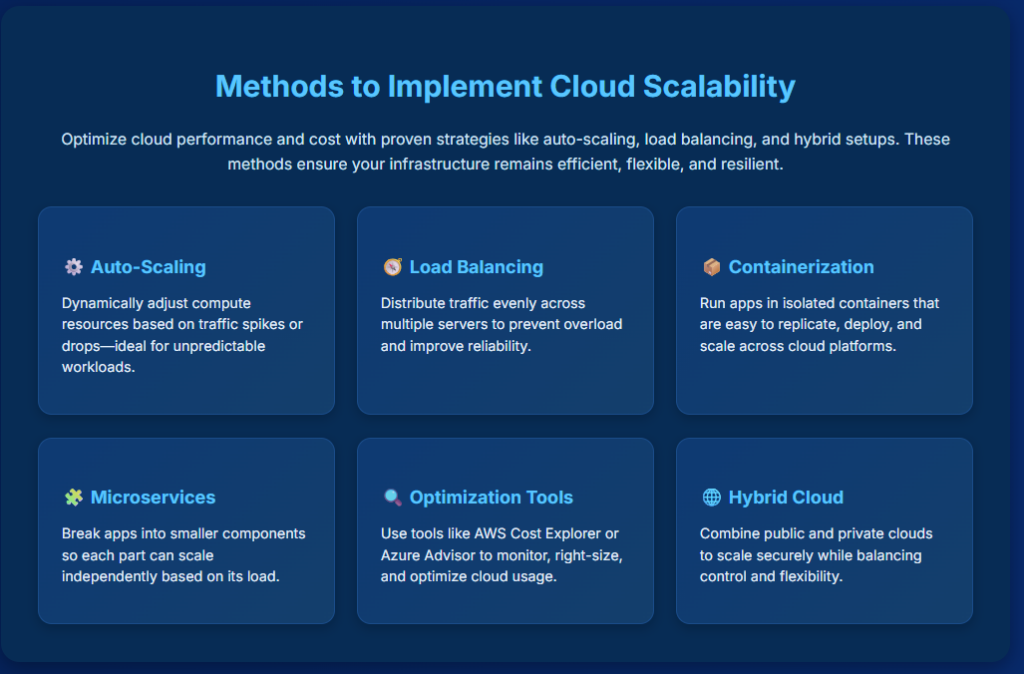Cloud computing has become the backbone of modern IT infrastructure, offering models like Infrastructure as a Service (IaaS), Platform as a Service (PaaS), and Software as a Service (SaaS).
These models allow businesses to leverage resources flexibly without owning physical hardware. One of the most crucial features that makes cloud computing stand out is scalability.
The ability to scale resources up or down as needed is a game-changer for businesses seeking efficiency, cost savings, and operational agility.
What is Cloud Scalability?

Cloud scalability refers to the cloud’s ability to adjust its resources based on demand. Whether increasing computing power during peak loads or scaling down during downtime, scalability ensures that businesses only use what they need.
This is especially important for growing companies that need their infrastructure to expand them without incurring heavy up-front investments in hardware.
Cloud Scalability vs. Cloud Elasticity
While cloud scalability and elasticity focus on adjusting resources to meet demand, they serve different purposes and operate on distinct timelines. Scalability refers to the long-term ability of a cloud system to grow or shrink based on predicted usage.
At the same time, elasticity emphasizes the real-time adjustment of resources to handle immediate fluctuations.
Understanding the differences between these two concepts is crucial for effectively managing cloud infrastructure and ensuring optimal performance.
| Aspect | Scalability | Elasticity |
| Purpose | Scaling resources up or down based on long-term needs. | Automatically adjusting resources in real-time to meet fluctuating demands. |
| Implementation | Manual or automated adjustments to meet increased or decreased load. | Resources are automatically allocated and de-allocated in real time based on usage spikes or dips. |
| Resource Usage | Resources are added or removed over time as per growth or demand predictions. | Resources are quickly scaled up or down in response to short-term changes in demand. |
| Use Case | Handling consistent, predictable growth. | Managing sudden traffic spikes or unpredictable workloads. |
| Business Impact | Enables long-term growth while keeping operational costs stable. | Reduces downtime and improves user experience during demand fluctuations. |
| Time Horizon | Best for long-term growth strategies. | Best for real-time fluctuations. |
| Scaling Type | Vertical or horizontal scaling (explained below). | Automatic real-time adjustment of resources. |
| Monitoring | Regular performance monitoring is needed to determine when scaling is necessary. | Constant monitoring to instantly react to demand changes. |
| Infrastructure Changes | It may require changes to the underlying infrastructure depending on scaling requirements. | Elasticity doesn’t typically require infrastructure changes, as it happens automatically. |
| Cost Management | Optimizes costs over time by matching resources with long-term demand. | Prevents unnecessary resource consumption and cost by automatically reducing unused capacity. |
| Performance Handling | Designed to handle gradual performance improvements as the business scales. | Handles real-time performance adjustments based on demand spikes. |
| Complexity | It can be complex to implement if significant infrastructure changes are needed. | It is less complex but requires an efficient system for real-time scaling. |
| Trigger Mechanism | Triggered by anticipated growth or regular intervals. | It is triggered automatically based on real-time metrics like traffic, CPU usage, or bandwidth. |
| System Downtime | Minimal, as scaling is often planned. | Virtually none, as elasticity, is designed to react immediately to changes. |
| Technology Dependency | Dependent on cloud infrastructure and the tools available for scaling. | Dependent on real-time monitoring and automation systems built into the cloud infrastructure. |
Why is the Cloud Scalable?
Cloud infrastructure’s scalability is rooted in its ability to offer flexible and distributed resources. Unlike traditional IT setups, where physical hardware defines capacity, cloud computing leverages virtualization and distributed computing, DevOps consultation to ensure smooth implementation.
This allows resources such as storage, processing power, and memory to be increased or decreased per the business’s requirements without downtime or extensive manual intervention.
Cloud providers, like AWS, Google Cloud, and Azure, offer various tools and services that make this scalability possible, including auto-scaling, container orchestration, and serverless architecture, which follow DevOps best practices.
In a cloud environment, businesses can:
- Scale up their resources to handle increased loads during peak times.
- Scale down when less demand is present, optimizing costs.
- Leverage multi-cloud and hybrid cloud environments to meet scaling needs efficiently.
Types of Scalability in Cloud Computing
In cloud computing, scalability comes in two primary forms: vertical and horizontal. Each type serves a unique function, enabling businesses to adjust their infrastructure based on changing needs.
Understanding these types of scalability helps organizations choose the right approach for maintaining optimal performance and cost efficiency in the cloud:
1. Vertical Scalability (Scaling Up/Down)
Vertical scaling involves increasing or decreasing the capacity of a single server or virtual machine, such as adding more CPU or RAM to handle more intensive tasks. It’s ideal for applications with limited instances or when scaling out horizontally is complex.
2. Horizontal Scalability (Scaling Out/In)
Horizontal scaling, on the other hand, refers to adding more servers or instances to distribute the load. This approach is commonly used in cloud environments, where multiple instances can handle different workloads simultaneously. It’s useful for applications that efficiently manage large amounts of traffic or data.
Benefits of Scalability in Cloud Computing
Scalability is one of cloud computing’s key advantages, allowing businesses to adjust resources according to their needs. This capability ensures cost efficiency and enhances performance, agility, and business continuity, which underscores DevOps benefits for business.
Organizations can maintain optimal operations without overinvesting in infrastructure by scaling resources up or down based on demand. Whether managing peak workloads or streamlining costs during quieter periods, below are the benefits of cloud scalability that significantly improve the overall efficiency and adaptability of modern businesses:

1. Cost Efficiency
Pay-as-you-go models in cloud computing allow businesses to pay only for the resources they use. As enterprises scale up or down, their costs adjust accordingly, leading to significant cost savings.
2. Performance Optimization
Scaling allows businesses to ensure they have the right resources to maintain performance. Whether dealing with increased traffic or computational tasks, scaling keeps the system running smoothly.
3. Flexibility and Agility
Scalability ensures businesses respond quickly to market changes, new opportunities, or sudden demand surges. This agility is crucial for staying competitive in a fast-paced market.
4. Business Continuity
Scaling resources in real-time helps businesses avoid downtime and ensures that applications and services remain available even during peak usage or unexpected demand.
When to Use Cloud Scalability?
Cloud scalability should be considered when:
- The business is experiencing steady growth, and the infrastructure needs to support that long-term increase.
- Traffic or demand can spike unpredictably during product launches, seasonal events, or marketing campaigns.
- Operational efficiency is a priority, and cost optimization is needed by reducing unused resources during off-peak times.
Methods to Implement Cloud Scalability
Implementing cloud scalability effectively requires various strategies and tools to optimize resource management and performance. In cases of DevOps outsourcing, these methods can be particularly effective.
From auto-scaling to load balancing, multiple methods ensure that cloud infrastructure can seamlessly adapt to changing demands.
These techniques help businesses maintain efficiency, minimize downtime, and optimize costs, whether through containerization, microservices architecture, or hybrid cloud solutions. You can use the methods below to ensure your cloud systems are scalable, responsive, and resilient.

1. Auto-Scaling
Automatically adjusts computing resources based on real-time demand. Popular among companies handling fluctuating workloads and a key consideration when leveraging cloud migration services for scalable infrastructure.
2. Load Balancing
Distributes incoming traffic across multiple servers or instances, ensuring optimal resource usage and preventing any one server from being overwhelmed.
3. Containerization
Containers allow applications to run in isolated environments, making scaling them across different cloud environments easier.
4. Microservices Architecture
Breaking down applications into microservices allows for independently scaling different components, improving flexibility and efficiency.
5. Cloud Optimization Tools
Tools like AWS Cost Explorer or Azure Advisor help manage resource usage and optimize scaling to ensure cost efficiency.
6. Hybrid Cloud Solutions
Combining private and public clouds allows businesses to scale their operations based on specific needs, using the best of both worlds.
Challenges and Considerations in Cloud Scalability
While cloud scalability offers numerous advantages, it also presents specific challenges and considerations that organizations must navigate.
From latency issues affecting performance to resource management complexities and security concerns, understanding these potential pitfalls is crucial for effective scalability.
Addressing these challenges requires careful planning and strategic implementation to realize scalability benefits without compromising efficiency or security:
Latency Issues
Network latency can become an issue while scaling, especially in geographically distributed cloud environments. Proper architectural planning is needed to address this.
Resource Management
As more resources are scaled, managing and optimizing them becomes crucial. Automated tools can help, but monitoring and intervention may still be needed.
Security Concerns
Scaling can sometimes open vulnerabilities, especially in multi-cloud environments. To mitigate risks, security should be integrated into the scaling process.
Final Words
Scalability enables businesses to grow and adapt while maintaining cost efficiency and performance. Through vertical and horizontal scaling, cloud services provide the flexibility needed for steady growth and unexpected demand surges.
However, careful planning and tool selection are crucial to implement and manage scalable cloud environments effectively.
At Folio3, we offer various services tailored to help organizations leverage cloud scalability to its fullest potential.
Our cloud optimization tools, auto-scaling solutions, and expertise in microservices architecture ensure that your business can easily navigate the complexities of cloud scalability.
Let us assist you in building a scalable cloud infrastructure that meets your unique needs and drives your success!






